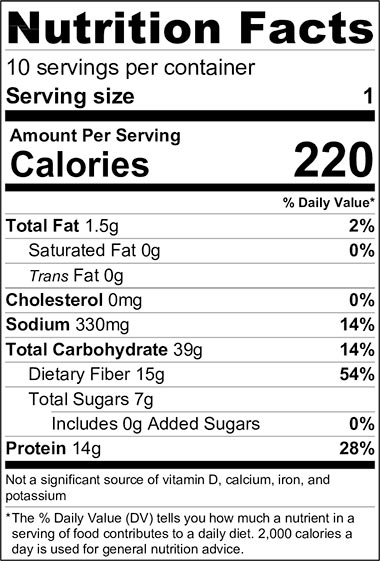Nutrition for Healthy Aging: Four Key Nutrition Messages for the Older Adult
Setting the Stage
The US population is changing; Americans are living longer. Nutrition is key to preventing and managing chronic disease, as well as to improving the quality of life in an aging population. As we age, our bodies change, as do our nutrition needs. Four naturally occurring body changes include a steady decline of lean muscle; increased deposition of fat mass, especially around the waist; decreased bone density; and a decrease in the sense of thirst and the capacities of other senses. This publication highlights four key nutrition messages that can help address these naturally occurring body changes.
Key Message #1: Eat more plant-based foods
Plant-based foods are foods that derive from plants, like vegetables, grains (choose whole grains), nuts, seeds, legumes, and fruits. Plant-based foods are rich in fiber, vitamins, and minerals. Research shows that consuming more plant-based foods can help to decrease blood pressure, lower cholesterol, manage blood sugars, and support weight management.
How to eat more plant-based foods:
- Eat a variety of vegetables and fruits. When eating vegetables and fruits, choose a variety of colors. Challenge yourself to eat all colors of the rainbow throughout the week: green, blue, purple, red, orange, yellow, and white.
- Track your fiber to create awareness. Fiber is a type of carbohydrate that is either partially digested or not digested at all in the gut. Eating more fiber can help improve gut health, blood sugar management, and helps you feel fuller longer (satiety). For persons fifty years of age or older, the United States Department of Agriculture (USDA) and the Institute of Medicine recommend that women eat 21 grams (g) and men 30 g of fiber each day. Please consult with your medical provider before increasing your fiber intake.
- According to the USDA’s MyPlate and University of Idaho Extension’s Idaho Healthy Diabetes Plate, plant-based foods should take up at least three-quarters of your plate at each meal.

Plant-based Recipe: Black Bean and Lentil Chili (Figures 1 and 2)
Ingredients:
- 2 (15 oz) cans of black beans, low or no sodium, drained and rinsed
- 1 (15 oz) can diced tomatoes, low or no sodium
- 1 (15 oz) can tomato sauce, low or no sodium
- 1½ cups lentils, dry

- 1 yellow onion, diced
- 2 bell peppers (color of your choice), diced
- 4 cloves garlic, minced
- 2½ cups vegetable broth, low or no sodium
- 2½ cups water
- 2 tsp oregano
- 1½ tbsp cumin
- 3 tbsp chili powder
Directions:
- Prepare all the ingredients as directed.
- Mix all the ingredients together in a pot and bring to a boil. Boil covered for 20–25 minutes and serve.
OR - Add all the ingredients to a slow cooker, mix well, and cook on LOW for 6–8 hours or on HIGH for 4 hours.
Key Message #2: Calcium and vitamin D are essential for bone health
Bone density decreases during the aging process. Achieving adequate amounts of vitamin D and calcium is important for the prevention of bone fractures and osteoporosis. Risk of osteoporosis is greater in women due to menopause and the tendency for women to have smaller, lighter bones than men. In order to absorb calcium, vitamin D is necessary. In addition, many individuals consume less cow’s milk and other calcium-rich dairy products due to lactose intolerance, which is more common in older adults.
- Ensure you are getting enough vitamin D daily (600–800 International Units [IU] per day). Vitamin D is a fat-soluble vitamin, meaning that we can store it in our fat mass. However, it is a nutrient of concern for many individuals due to lack of sun exposure and low consumption of vitamin D–rich foods. A vitamin D supplement may be recommended during winter months where sun exposure of the skin may be limited. Consult with your doctor before taking a supplement.
- Consume three servings of calcium-rich food daily (1,200 milligrams [mg] per day). A serving of cow’s milk and calcium-fortified beverages is 1 cup or 8 fluid ounces. Cow’s milk has roughly 300 mg of calcium per cup. Calcium-fortified soy, almond, coconut, rice, and cashew milk have varying amounts of calcium per cup. Check the nutrition label for calcium content.
| Type of Beverage | Pros | Cons |
|---|---|---|
| Cow’s milk | Higher protein content per cup; consistent calcium; fortified vitamin D | Contains lactose (can choose lactose-free cow’s milk), varying fat content (can choose 1% or skim) |
| Soy drink | Most comparable to cow’s milk with protein content per cup; lactose-free; plant-based | May contain added sugar; varying calcium and vitamin D fortification by brand |
| Rice drink | Lactose-free; plant-based | Low protein content per cup; high amount of carbohydrates per cup (may consider if diabetic); may contain added sugar; varying calcium and vitamin D fortification by brand |
| Coconut drink | Lactose-free; plant-based | Low to no protein content per cup; may contain added sugar; varying calcium and vitamin D fortification by brand |
| Cashew drink | Lactose-free; plant-based | Low to no protein content per cup; may contain added sugar; varying calcium and vitamin D fortification by brand |
Key Message #3: Focus on protein with an emphasis on distribution
As we age, muscle mass steadily declines, increasing the risk of sarcopenia. Sarcopenia is a clinically diagnosed loss of muscle mass and strength, which in turn affects balance, function, and mobility. Research has led to the recommendation that after reaching fifty years of age, adults need to increase their daily protein intake. Protein thus simply becomes even more important as we age.
- Aim for an optimal 30 g of protein at each meal. Evidence suggests that a protein threshold of about 30 g at one time allows for the most efficient use of protein to build muscle. Any more or any less protein at one meal may result in less efficient protein use.
- Protein should make up one-quarter of your plate. See the USDA’s MyPlate or the Idaho Diabetes Plate graphics for reference. One-quarter of a plate roughly equals 3 ounces (oz) of protein. You can also use the palm of your hand or the size of a standard deck of cards to help estimate what 3 oz of protein looks like.
| Source | Chicken Breast | Fish (cod) | Turkey Breast | Pork Tenderloin | Ground Beef (90% lean) | Beef Tenderloin |
|---|---|---|---|---|---|---|
| Ounces | 3 | 5 | 3 | 3 | 3 | 3 |
| Protein (g = grams) |
26 g | 25 g | 24 g | 22 g | 23 g | 20 g |
| Note: This protein chart provides an estimate of the amount of protein in animal-based protein sources. As we aim for 30 g of protein at each meal, keep in mind that dairy and other foods served with a meal may contribute to total protein. For example, a cup of cow’s milk contains roughly 9 g of protein. Pairing it with 3 oz of chicken provides optimal protein too, thus giving you a different option if you’d rather not just increase your serving of chicken. | ||||||
Key Message #4: Remember to stay hydrated.
Dehydration is one of the most overlooked health issues in older adults. The first symptom of dehydration is thirst. Aging naturally affects our senses, making our perception of thirst more difficult to identify. Following thirst, mild dehydration can result in mood changes, confusion, and short-term memory loss. These can often and should not be confused for natural symptoms of “getting older.” Long-term symptoms of dehydration can include constipation, headaches, and poor kidney function.
- Drink at least 64 oz (eight 8 oz glasses) of water each day. Because thirst can be more difficult to identify and mild dehydration can result in confusion and short-term memory loss, use a water bottle that displays ounce measurements to help with tracking daily water consumption.
- Educate family members and friends. Make sure more people are aware of the benefits of staying properly hydrated so they can support your water-intake goals and thus make it even easier for you to avoid developing the symptoms of dehydration.

Infused Fruit Water (Figure 3)
Ingredients:
- Frozen fruit
- Vegetables of your choice, like cucumber
- Herbs of your choice, like mint and rosemary
Directions:
- Add the desired ingredients of your choice to a pitcher.
- Add water to fill the pitcher.
- Allow water and chosen ingredients to sit and mix well in the refrigerator (at least one hour).
Note: Fresh fruit may also be used. Frozen fruit is suggested as it is already denatured and will create a stronger flavor.
References
United States Department of Agriculture. n.d. ChooseMyPlate. “What is MyPlate?” https://www.choosemyplate.gov/eathealthy/WhatIsMyPlate. Accessed June 30, 2020.
University of Idaho Extension. 2009. Healthy Diabetes Plate. “What’s On Your Plate Today?” uidaho.edu/extension/publications/publication-detail?id=ecs0009. Accessed June 30, 2020.
About the Authors
Jackie Amende, MS, RDN, LD — Family and Consumer Sciences Extension Educator, University of Idaho (UI) Extension, Canyon County
Bridget Morrisroe-Aman, MSW — Family and Consumer Sciences Extension Educator, UI Extension, Ada County
Julie H. Buck, EdD, RDN — Family and Consumer Sciences Extension Educator, UI Extension, Bingham County
BUL 975 | Published July 2020 | © 2022 by the University of Idaho








